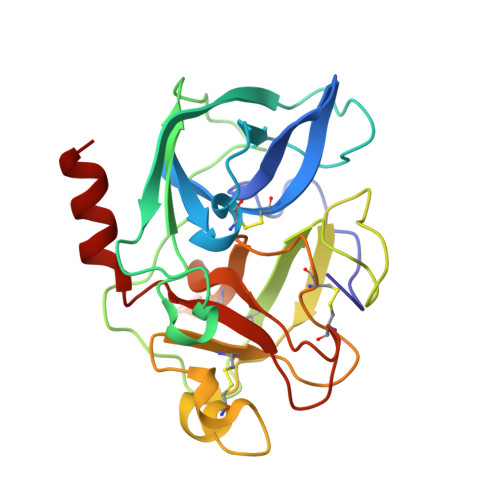'Ph-Jump' Crystallographic Analyses of Gamma-Lactam-Porcine Pancreatic Elastase Complexes
Wright, P.A., Wilmouth, R.C., Clifton, I.J., Schofield, C.J.(2000) Biochem J 351: 335
- PubMed: 11023818
- Primary Citation of Related Structures:
1E34, 1E35, 1E36, 1E37, 1E38 - PubMed Abstract:
beta-Lactams inhibit a range of enzymes via acylation of nucleophilic serine residues. Certain gamma-lactam analogues of monocyclic beta-lactams have also been shown to be reversible inhibitors of porcine pancreatic elastase (PPE), forming acyl-enzyme complexes that are stable with respect to hydrolysis. Crystallographic analysis at pH 5 of an acyl-enzyme complex formed with PPE and one of these inhibitors revealed the ester carbonyl located in the oxyanion hole in a similar conformation to that observed in the structure of a complex formed between a heptapeptide (beta-casomorphin-7) and PPE. Only weak electron density was observed for the His-57 side chain in its 'native' conformation. Instead, the His-57 side chain predominantly adopted a conformation rotated approx. 90 degrees from its normal position. PPE-gamma-lactam crystals were subjected to 'pH-jumps' by placing the crystals in a buffer of increased pH prior to freezing for data collection. The results indicate that the conformation of the gamma-lactam-derived acyl-enzyme species in the PPE active site is dependent on pH, a result having implications for the analysis of other serine protease-inhibitor structures at non-catalytic pH values. The results help to define the stereoelectronic relationship between the ester of the acyl-enzyme complex, the side chain of His-57 and the incoming nucleophile during the reversible (de)acylation steps, implying it is closely analogous to the hydrolytic deacylation step during catalytic peptide hydrolysis.
Organizational Affiliation:
The Oxford Centre for Molecular Sciences and The Dyson Perrins Laboratory, South Parks Road, Oxford OX1 3QY, UK.



















